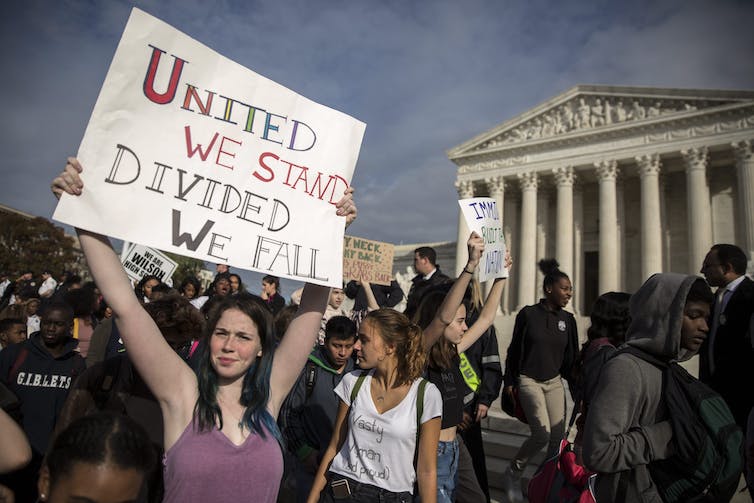Recent research suggests a growing gender gap in political leanings around the world. In Gen Z, the youngest voting generation, young women are becoming more progressive than men.
Young Australian women, too, are significantly shifting towards the political left – but so are young Australian men, although at a relatively slower rate.
I’ve analysed data from the Australian Election Study, spanning 1996 to 2022, to find out what’s happening.
Just 24.3% of Millennials born between 1980 and 1994 – 21.9% of men and 25.7% of women – said they voted for the Coalition in 2022, representing the lowest level of support for either major party among younger people in the 35-year history of the Australian Election Study.
A slightly higher proportion of Gen Z voted for the Coalition: 24.6%, with a gender breakdown of 34.0% of men and 29.8% of women.
(These numbers will slightly vary based on exact generational definitions – birth-year boundaries – and whether non-voters are excluded from the analysis.)
I found that Australian Millennial and Gen Z men are more conservative than their female counterparts, but are more progressive than men of previous generations at the same stage of life. Across genders, these generations also report being in the political centre less than previous ones.
This runs counter to reported trends in most countries, where women have been shifting left “while men stand still”. In fact, in some countries like Germany, signs suggest young men are moving right.
What explained the seismic 2022 federal election? The Australian Election Study has answers
A global youth political gender gap
A substantial global gender gap has opened in the past six years, following decades of roughly equal ideological distribution. Young American women aged 18-30 are now 30 percentage points more liberal than their male peers, according to US Gallup data.
Germany reflects a similar 30-point divide, while the UK sees a 25-point gap.
In 2022, almost half of Polish men aged 18-21 supported the far-right Confederation party, in contrast to just a sixth of women in that age group. In Germany, there are signs young men under 30 are moving towards the far-right Alternative for Germany (AfD), actively opposing immigration more than their elders.
Shawn Thew/AAP
The pattern is reflected beyond the West, too. It is evident in China, Tunisia and South Korea – where, in the 2022 election, young men backed the right-wing People Power party and young women backed the liberal Democratic party.
In all these cases, the dramatic divide is either exclusive to the youngest generation or is far more pronounced than the gender gap in older generations.
How I reached my findings
After each federal election, the Australian Election Study survey asks respondents to place themselves on an 11-point ideological scale, where 0 is extreme left, 10 is extreme right, and 5 is often interpreted as neither left nor right (the political centre).
I analysed this data, using six generational categories.
They were:
- War generation (born 1920s and came of age during WWII – 1,305 participants)
- Builders (born between 1930 and before the end of the WWII – 4,133 participants)
- postwar Baby Boomers (born 1946–1960 – 6,651 participants)
- Gen X (born 1961-1979 – 5,229 participants)
- Millennials or Gen Y (born 1980–1994 – 1,672 participants)
- Gen Z (born after 1994 – a smaller size of 264 participants, which requires caution in statistical conclusions).
A person’s position on the ideological scale is influenced by their age, gender and education.
Young Australian voters helped swing the election – and could do it again next time
Women’s move to the left
In Australia’s 2022 election, the Coalition received its lowest-ever share of the women’s vote – just 32%. Conversely, the Labor party attracted more women than men (albeit to a lesser extent).
Reasons included a fierce rise in feminist views following the global #MeToo movement, the Liberal government’s poor response to sexual assault claims, and the mistreatment of women within the Liberal party and the parliament.
This reflects the global analysis reported by The Financial Times: the #MeToo movement has empowered young women worldwide to embrace fiercely feminist values, influencing their political outlook.
But the Coalition’s loss of support among women is not isolated to the 2022 election: it’s been happening since the early 2000s.
Men moving left too – but in lower numbers
My analysis showed women are significantly more likely to be progressive than men. Across generations and political views, the gender gap has widened.
The most recent generation, Gen Z, appears to be the most progressive, with women in particular starkly preferring the left and placing themselves at the centre in dwindling numbers.
However, while Gen Z has more men than women on the right, it has less right-leaning men than any other generation – so it would be wrong to say our young men are rushing to the right, like in South Korea or Germany.
The Australian data mirrors international trends, with a slight twist. Over the past decades, and across generations, Australian men and women have been moving to the left and away from the right. At the same time, they have moved away from the centre (though this is more pronounced for women).
Despite the gender gap, they are heading in the same direction.
Exploring the connection between gender and generation, I tailored my analysis to see what happened when other factors that influence political leanings were taken into account, like educational attainment, marital status and home ownership.
Gender remained a significant influence, though this varies depending on the generation, with some generations more gender-divided than others.
Tertiary education was also significant. Women with a tertiary education are likely to be more progressive than those without one. The same applies to men, although to a lesser extent.
Men and women who are married and own a home are more conservative in their political views. Income itself is neither substantial, nor significant in its effect.
Implications for Australian politics
The gender gap, along with many other factors, is reshaping how young Australians engage with politics. Acknowledging and addressing this divide is a vital step towards fostering an inclusive and representative democracy.
As better educated, younger women become a formidable force in shaping political landscapes, political parties risk losing touch with this influential segment if they fail to address gender-specific issues, such as those related to education, healthcare, childcare, and workplace equality.
The Coalition is definitely on notice, but all political parties must adapt their strategies to align with the evolving demographics.
The move to the left may not stop at left-of-centre parties, but continue further left, towards the Greens for example. Generational replacement may not necessarily continue to favour the Labor party if their party positions do not speak to young women in the next election.
Note: I wrongly synonymise “sex” and “gender” in my analyses, because survey research is yet to properly acknowledge and capture the gender diversity that exists in our society. However, I note it is impossible to truly understand the gender gap (and the progressive direction of younger people’s leanings) in politics if we continue to discuss the “modern” gender gap while still “traditionally” defining gender as a binary concept.




